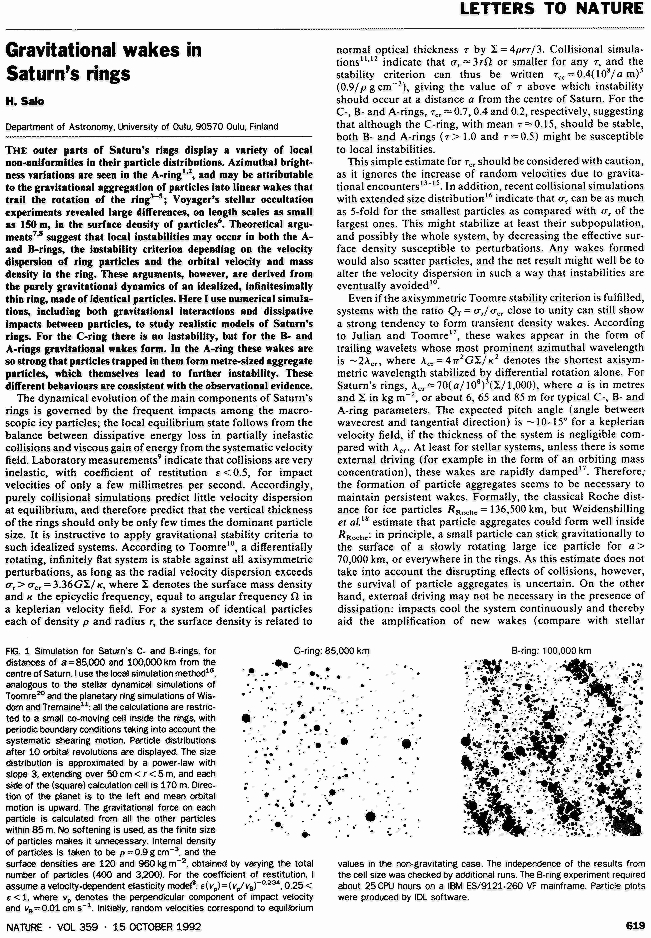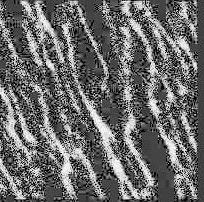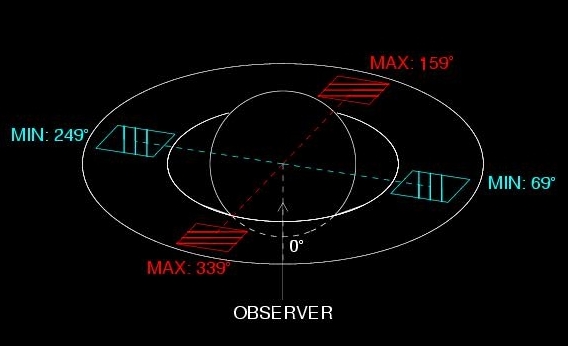CASSINI CONFIRMS THE GRAVITATIONAL WAKE MODEL FOR SATURN'S A-RING
(Salo 1992, Nature)

(Salo et al. 2004, Icarus).

CASSINI CONFIRMS THE GRAVITATIONAL WAKE MODEL
FOR SATURN'S A-RING,
Suomeksi
(Heikki Salo,
Dept. of Physical Sciences, Div. of Astronomy, Univ. of Oulu, Finland)
email: heikki.salo@oulu.fi,
tel. +358-(0)8 553 1931, fax +358-(0)8 553 1934
Dynamiikan ryhmä
./.
Dynamics group
Various occultation experiments carried out by the NASA Cassini
spacecraft have confirmed the long-suspected existence of gravity
wakes in Saturn's A ring. These results of Cassini UVIS (ultraviolet),
VIMS (visual and infrared) and RSS (radio) occultations were published in
the Americal Astronomical Society Division for Planetary Sciences
(DPS) meeting in Cambridge, England, 4-9 September 2005.
The existence of trailing density enhancement was anticipated already
by Colombo, Goldreich and Harris (1976), and by Franklin and Colombo
(1978). The first quantitative dynamical simulation model was
constructed in the University of Oulu
(Salo 1992, Nature). Detailed photometric modeling of wakes, also
carried out in Oulu (Salo et
al. 2004, Icarus) , explained well the Voyager observations of the
A ring azimuthal brightness asymmetry. Moreover, they predicted that
brightness variations should be accompanied by optical depth
variations, as is now confirmed.
Dynamical simulations of gravity wakes:

A-ring model (mpeg
7.5MB) Displays an identical particle simulation corresponding to the
mid A-ring, for an assumed internal density of 0.45 gr/cm3. The
coefficient of restitution is 0.5, and the dynamical optical depth
0.5. Size of the calculation region is 8 by 8 Toomre critical
wavelengths.
ORIGINAL 1992 DPS ANIMATIONS: (see the 1992 Nature article).
An extended q=3 power-law
size distribution from 0.5 to 5 meters, Bridges coefficient of
restitution. For solid ice density 0.9gr/cm3 the Saturnocentric
distances of the two simulations correspond to 100 000 and 128 000
km. For density 0.45gr/cm3 the distances correspond to 126 000 km and
161 000km.
Moderate gravity leading to wakes
Strong gravity leading to aggregates
NEW MOVIES 15.11.2010: very similar to 1992 DPS animations, except for using a larger number of
particles
77 Mbytes (slow formation of aggregate)
9 Mbytes (fast)

How do gravity wakes produce azimuthal asymmetry (ring
brightness or transparency at a fixed distance varies as a function of
longitude)?
The average direction of the wakes trails by
about 21 deg with respect to the local orbital motion. In low
elevation angle observations the wakes are seen closest to end-on at
ring longitudes of 249 and 69 degrees. In this case the rarefied
regions between wakes are visible, reducing the reflecting surface
area: this corresponds to minimum brightness and maximum transparency
of the rings.
Strongest effect is expected for roughly 10-15
degree elevation.From (Salo et
al. 2004)



